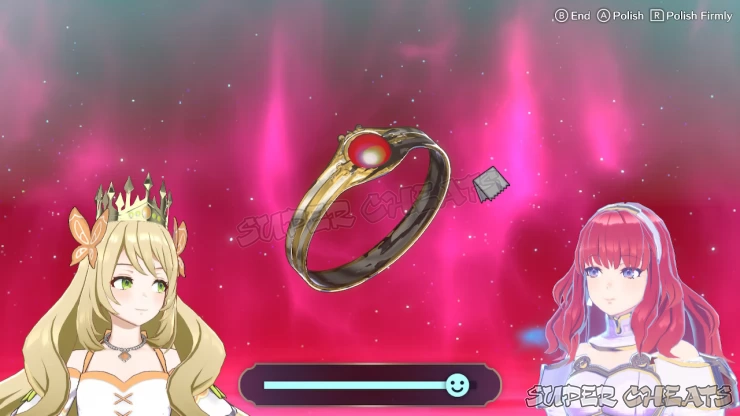Ring Chamber Guide
As your base of operations, Somniel has several facilities at your disposal that can help you build and train your units effectively. In our Ring Chamber guide, we will discuss the various features and options this facility has, and how you can take advantage of them.
Fire Emblem Engage is a latest installation for the critically-acclaimed Fire Emblem series, offering a fresh approach to the tried-and tested tactical, turn-based JRPG formula fans have seen in recent years. Players are treated with the return of the Triangle System, weapons with no durability, and of course, the fresh new Emblem/Bond Ring mechanic.
The Ring Chamber becomes accessible after clearing Chapter 4. Once unlocked, it’s highly recommended to use its features regularly to ensure that your party’s combat capability is in tip-top shape. The Ring Chamber itself offers a variety of features, which we will discuss in their individual sections below.

Inherit Skills
This option allows you to spend a unit’s SP to learn an unlocked bond skill. SP is earned individually (please refer to our dedicated page for farming SP) as long as a unit wears either a Bond Ring or Emblem Ring/Bracelet. Bond Skills are only acquired from Emblems as a unit increases his/her bond level with said emblems. Bond levels are counted separately among several emblems and one unit can have bonds with several emblems.

Originally, you can only increase the bond levels of Emblems up to LV10. You can increase this bond level cap up to LV20 (thus unlocking more bond skills) by completing the Emblem’s own paralogue. You can start doing this right after you acquire Emblem Lucina after clearing Chapter 11. The case is different for DLC emblems (Tiki & Edelgard/Dimitri/Claude) in which you can increase their bond levels up to LV20 right from the start.
Here are some important notes about Skill Inheritance:
* A unit needs to be at least Bond LV5 to be able to “purchase” inheritable skills from the Emblem.
* Not all Emblem skills can be inherited; special skills like engage attacks and engage sync skills can’t be inherited.
* Weapon Proficiency is different from Weapon Mastery. Weapon Proficiency is a passive and permanent status applied to the unit, indicating how proficient they are for using a weapon type. Some classes require specific proficiency levels (ranging from Rank D to S) before you can change a unit into them. Weapon Mastery are inheritable skills that provide bonus effects or stats when a unit acts while using the specified weapon type.
* Weapon proficiencies don’t need to be inherited; once a unit unlocks it, it will automatically be added to their skill set.
* After spending SP and inheriting the skill, you need to access Inventory > Manage Skills in order to equip the skill to the unit. A unit can have up to two inherited skills.
* Some inherited skills are stackable. For example, equipping both Luck +12 and Luck+10 will provide the unit a +22 boost on their Luck stat.
* Beware of skill overlaps; this happens when one of the inherited skills equipped to a unit is also applied by the emblem he/she is currently paired with. You may need to replace the overlapping skill with another one until you switch the paired emblem.
Create Bond Rings
This option allows you to craft Bond Rings by selecting an emblem and spending the required amount of bond fragments. This is highly encouraged early on, especially when they’re needed by your other units to boost their stats and enable them to earn SP in combat. (Units without emblem or bond rings will not earn SP at all so it’s very important to give all your units any bond ring at least)
Creating Bond Rings requires 100 fragments each but you can make 10 rings all at once by spending 1000 fragments. Take note that the rarity of the rings is generated randomly and the characters imbued on the created rings will be associated with the selected emblem. You can treat this as the gacha portion of the game since it’s possible to get multiple copies of the same character with the same or varying ranks/rarities.
As you gain access to more emblem rings in the later part of the story, you’ll probably have a “core” team already (your personal army of the units of your choice) that you’ll deploy frequently. As such, you’re most likely to give them the more powerful emblem rings/bracelets anyway, with maybe a rank S bond ring or two for your other units. This makes the process of creating and combining bond rings lose its value in mid or late-game situations.
Meld Bond Rings
This option allows you to combine multiple copies of the ring with the same rank to create a single ring with a higher rank. (The number of copies required be indicated during the actual melding process) Melding uses Bond Fragments to complete the process; the table below displays the amount of bond fragments needed for combining (melding) bond rings.
| Ring Rarity | Bond Fragment Cost |
|---|---|
| Rank C to B | 100 |
| Rank B to A | 1000 |
| Rank A to S | 10000 |

Polish Rings/ Bracelets
As you battle, the rings or bracelets will get muddied and dirty over time. Selecting this option will allow you to select a unit to clean rings and bracelets. Doing so will increase the bond between the cleaner and the Emblem residing in the ring. This is another great way of improving bonds between units and Emblems without Emblem Training or pairing them up in combat. You don’t need to clean the rings and bracelets after every battle; it’s worth checking it out after at least three battles.

Engage Weapons
The last option allows you to improve Engage Weapons through Augmentation. Engage Weapons are your Emblems’ signature weapons that your unit can only tap or use while in Engage mode. These weapons are already quite powerful in their own right but there’s no harm in improving them further, especially if you’re planning to tackle high-level, end-game content like the Tower of Trials.

Augmenting weapons require Crystals and Banes. Crystals improve specific stats like Might (Mt) Crystals boost the weapon’s Mt stat while Banes add “effectiveness” against certain enemy types. (For example, effective vs armored, vs fliers, vs dragons, etc) Engage weapons with existing effectiveness on them (like Emblem Lucina’s Noble Rapier that’s already effective against Cavalry and Armored enemies) can’t be modified with Banes; only crystals.

These items can only be acquired for clearing Tempest Trials maps or Relay Trials. The latter however, is an online co-op mode so a Nintendo online subscription is required. It’s recommended to have several units at LV25 (Advanced Class) or above to have a higher chance of clearing these maps. Trial maps are different from standard Skirmish maps since they don’t provide EXP and SP right after units take action.
The number of augments you can install on a weapon is determined by its Capacity. You can unlock an additional capacity by reaching the emblem’s Bond LV10 and by reaching its Bond (support) rank B.
You can change an Engage Weapon’s Augmentation by stripping said augment. Take note however that stripping crystals will permanently destroy the old augment instead of refunding it so it’s very important to decide what augment you’ll install first. Additionally, you can also increase the capacity of the weapon so you can add more augments on it instead of stripping the old augments.
This concludes our Ring Chamber Guide for Fire Emblem Engage. Please check out our other pages for the game for more Fire Emblem Engage content!
 Join us on Discord
Join us on Discord
